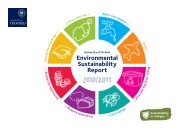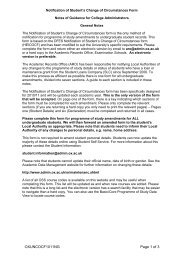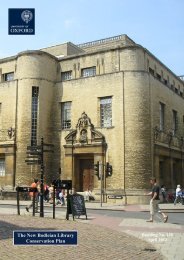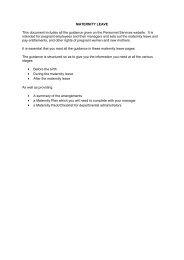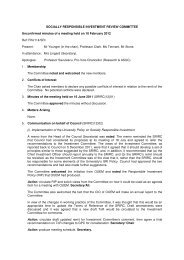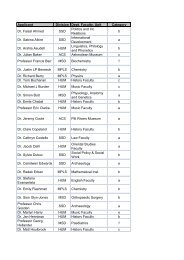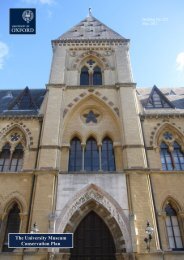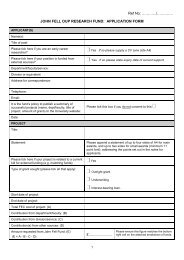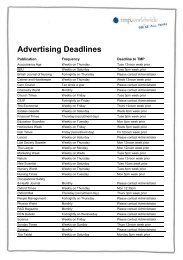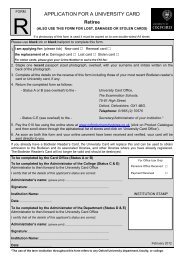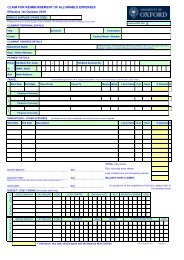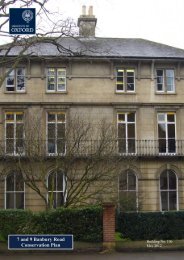Dyson Perrins Laboratory - Central Administration - University of ...
Dyson Perrins Laboratory - Central Administration - University of ...
Dyson Perrins Laboratory - Central Administration - University of ...
- No tags were found...
You also want an ePaper? Increase the reach of your titles
YUMPU automatically turns print PDFs into web optimized ePapers that Google loves.
2.2 History <strong>of</strong> the <strong>Dyson</strong> <strong>Perrins</strong> <strong>Laboratory</strong>The <strong>Dyson</strong> <strong>Perrins</strong> <strong>Laboratory</strong> has its origins in the 1909 Committee on <strong>University</strong> Teachingin Chemistry. Historically Chemistry teaching had been confined to various collegelaboratories. A <strong>University</strong> Chemistry <strong>Laboratory</strong> was constructed alongside the <strong>University</strong>Museum in 1855-60. This was known as the Abbot’s Kitchen, being based on the fourteenthcenturyAbbot’s Kitchen at Glastonbury. Unsurprisingly, being based on mediaevalecclesiastical models rather than the purpose-built laboratories at that time appearing on theContinent, this building was quickly insufficient for its needs. It was heavily extended in1878, with a far-more-practical teaching laboratory, which, whilst no longer up to modernstandards, remains in use to this day. 4 This alleviated the problem somewhat but by the earlytwentieth century chemistry teaching and research in Oxford was woefully inadequate, andhad long since been overtaken in academic stature by Manchester <strong>University</strong>.The 1909 Committee on <strong>University</strong> Teaching in Chemistry reported that ‘the provision madeat present by the <strong>University</strong> for the teaching and study <strong>of</strong> chemistry is inadequate, both inrespect <strong>of</strong> the staff and as regards laboratory accommodation…The committee recommendsas urgently needed: Two <strong>University</strong> Pr<strong>of</strong>essors at £900 a year, one assigned to the subject <strong>of</strong>organic chemistry and the other to that <strong>of</strong> inorganic chemistry.’ The Committeerecommended that a new building should be constructed to house the two laboratories andthat it should be located on <strong>University</strong> property, close to the <strong>University</strong> Museum, and withsufficient space for future expansion. 5The Hebdomadal Council estimated that £25,000 would be required to construct the requiredlaboratory and it petitioned the <strong>University</strong> Endowment Fund in March 1910 for the necessaryresources. The funds were by no means easily obtained. It was not until William Odling, theWaynflete Pr<strong>of</strong>essor <strong>of</strong> Chemistry, announced his retirement in 1912 that the conservative<strong>University</strong> Chest would meet the requests <strong>of</strong> the liberal Hebdomadal Council. It was agreedthat a new laboratory would be constructed and the <strong>University</strong> Chest made £15,000 available.An organic chemist, W.H. Perkin held the Chair <strong>of</strong> Chemistry at Manchester <strong>University</strong>, theleading chemistry department in Great Britain, and in 1909 had designed, with PaulWaterhouse, Manchester’s Morley <strong>Laboratory</strong>. The specifications for this were based onPerkin’s experience <strong>of</strong> Adolf von Baeyer’s laboratory in Munich, where he had worked as adoctoral student. Perkin was initially invited to Oxford in 1912 as an Elector for Odling’sreplacement, though it was quickly made clear that he was the preferred option for theWaynflete Chair, prompting him to resign his Electorship to stand as a candidate. 6 Researchwas Perkin’s first priority and, when the Electors <strong>of</strong>fered the rôle to him in November 1912,he accepted on the condition that he should be provided with a new laboratory and that in themeantime he should be given a fully-equipped temporary laboratory in the <strong>University</strong>Museum.4 Inorganic Chemistry <strong>Laboratory</strong>: Conservation Plan (Estates Services, January 2012).5 Curtis, R., Leith, C., Nall, J., and Jones, J., The <strong>Dyson</strong> <strong>Perrins</strong> <strong>Laboratory</strong> and Oxford Organic Chemistry1916-2004 (Oxford, 2008) 15-16.6 Ibid, 17.The <strong>Dyson</strong> <strong>Perrins</strong> <strong>Laboratory</strong>, Oxford 14Conservation Plan, May 2012



